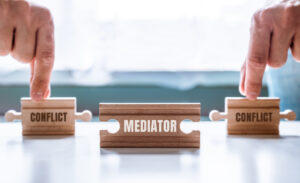
Mediation is a really successful way to resolve workplace conflict. You wouldn’t be surprised to hear that from a mediator! But the statistics also show this very clearly. When I deliver training courses, I invite participants to take a guess as to the success rate of mediation – this is the percentage of cases that go into mediation that are resolved, i.e. that result in an agreement or an action plan at the end. I can recall one occasion where a training participant guessed around 90% but generally the guesses are more modest – 40%, 50%, 75% perhaps.
In fact, it’s more like 93% in workplace mediation. A huge number. So, what is it about this structure, this role, this approach that makes it quite so successful?
You won’t, I suspect, be surprised to hear that it’s nothing to do with hats, rabbits, and wands. For me, it boils down the four principles of mediation and what specifically those principles deliver. In this blog post, we will consider those principles and how they provide a rare opportunity for the parties to discuss and resolve their issues.
What are the mediation principles?
Mediation is often described as a semi-formal, or pre-formal process. There is some flexibility in the structure, in terms of the mode of delivery (in-person, telephone or online, or a mix of those) and arrangements (all the meetings on one day or incorporating some time in between the stages for reflection).
But, that flexibility in structure is based on four fundamental principles that define mediation. Those are:
- Impartiality: as a mediator I am not aligned to any one side or another. I am there to support everyone involved in the process – 2 parties, 3, or more. I am not on any one side or another – or, as I prefer to describe it, I’m on everyone’s side. I’m there to support them all.
- Neutrality: you are neutral. I don’t have an interest in how the issues resolve – my interest is to facilitate and hold the space for the parties to work out what issues need to be addressed for the working relationships to function (well-enough or to really thrive) and what actions are needed to address those issues.
- Voluntary: it’s crucial for everyone involved to make a choice to take part in the mediation (or not). This decision is really important. Simply put, you can’t force people into the room and achieve a lasting resolution…. It simply doesn’t work. Sometimes you may have someone who feels that they are choosing to take part because their other options were worse, but they are still taking that decision for themselves.
- Confidentiality: underpins the whole process. It is absolutely essential for those involved the reassurance to know that they can talk honestly about what’s been happening, the impact, discuss ideas of how issues could be resolved, without the worry that anything could be used against them afterwards, which could really constrain the discussion.

Those sound like nice things to have. And they are. But they are much more than that. You can absolutely tweak and adjust elements of the mediation to ensure that it’s delivering a constructive space for the parties. But these principles underpin it all.
Why are those critical?
Safe space
It’s because those create a safe, psychological space for the parties to speak and to listen constructively, with empathy. The parties are empowered to own the discussion of issues and resolution. They can voice their perspectives on what has been causing concern in the relationship. The parties can share the impact on them, which may involve frankly courageous honesty and openness, talking through perhaps painful emotions. AND they can talk through what they need from that working relationship in the future. The safe space is absolutely essential to give the parties the opportunity to do that.
Being heard
They get to have their voice heard by the other party. And this is so powerful. It’s such a core need for all of us – to be heard. Also, to be understood – and to build an understanding of where the other party is coming from.

Often at least one party will say to me as mediator, ‘do you know, this is first time that I feel that someone has really listened to me’. Because we find that this doesn’t happen as much in our working environments as we might think.
And this feeling heard is – I believe – what allows the parties to shift their focus from past hurts to a future where they enjoy a productive working relationship. That’s where the magic is.
For me, there is magic throughout the mediation process. The initial calls that with parties give them a lot of space to talk through what’s been happening and what they need. And when I bring the parties together in a joint meeting, facilitated by me as the mediator – that’s where they have the chance to share their voice and to hear what the other party wasn’t to voice – this is where you really do see the magic. There can be a palpable shift in the way they view the conflict, they way they view what has happened, how they see the other party and even what they want to get out of it. At times, you can almost hear the pressure in the room easing as they start to understand each other better.
This is why I think mediation offers something quite unique compared to other approaches to resolve conflict. That’s the magic.

 By
By 


